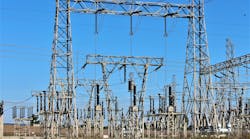Distributed automation initiative enhances circuit capacity and protection in overloaded downtown area.
Located along the banks of the DuPage River, 30 miles (48.3 km) west of Chicago, the city of Naperville, Illinois, U.S., is home to more than 130,000 people and is one of the fastest growing communities in the United States. This growth has caused constant redevelopment of its downtown business district, creating an increasing load density.
The city's Department of Public Utilities includes a municipal electric utility (DPU-E). The utility's distribution system is almost 90% underground, and its nominal voltage is 12.47 kV transformed from 34.5 kV and 138 kV and is supplied at six points of service from provider ComEd. DPU-E's typical circuit design uses 600-A main-looped feeders from different substations, which are tapped to serve distribution loads at padmounted switchgear. In addition, the 200-A fused taps from the switchgear are looped back to different switching devices for added reliability. It is the current design philosophy to install distribution automation teams on all primary feeders - 10 per year - using a combination of overhead and underground switchgear with automatic reconfiguration capabilities.
A single 200-A three-phase loop was feeding the downtown area and was protected only by 140-A fuses. This line fed a majority of the downtown as well as some residential areas, and the load had increased by 60% in the last five years to nearly 5300 kW of demand.
Numerous outages on this line required some way of mitigating the effects of the outages. The line was not scheduled for upgrade until after the installation of a substation and duct bank in 2001 and 2002, respectively. Due to the outage frequency and rapid growth at the outer limits of the existing feeders, however, another solution was imperative. Naperville had to rethink its entire downtown feeder system.
A single mainline feeder would have alleviated the problem, but with construction nearly three years away, the city needed a short-term plan. The utility installed a 2000-ft (610-m) 12.47-kV underground cable in conduit to be fed on either side by overhead lines through switches. DPU-E located the cable 2 miles (3.2 km) from the closest substation. The only feasible solution to make the feeder more reliable was to automate the switches to restore as many customers as possible between the two overhead feeders for loss-of-source and fault-related interruptions.
Because of space restrictions, the town installed submersible switchgear in an alley between two shops. Service to existing customers required a second switchgear near a parking garage in what was thought to be a remote area. But further development placed it in a high-traffic area, which required another submersible switch.
With both submersible switches in the main loop feeding downtown, one of them had to be automated to provide adequate service reliability due to the distribution of load. This type of hybrid application had never been attempted, so DPU-E worked closely with equipment manufacturers to create the new technology. The design envisioned three switches working as a team using EnergyLine's IntelliTEAM logic. The team consisted of one overhead S&C Scada-Mate switch separating a large block of residential load from the downtown, one S&C PME-9 remote supervisory padmounted switch as the normally open point and one automated S&C Vista as the second submersible switch (Fig. 2).
Each switch is equipped with an IntelliTEAM control, which allows the switches to work as a team via peer-to-peer (PTP) communications. Operating together, the switches can detect and isolate a fault anywhere on the loop and restore service from the other available overhead feeder. In similar fashion, the team also can provide a distributed automatic transfer capability at each switch if either overhead feeder is lost. This combination provided DPU-E with a highly reliable interim solution for the downtown load. The utility will further integrate the load into additional teams of automated switches when it completes substation and duct bank projects in the next three years.
The Overhead Team Member The overhead team member has three components: the S&C Scada-Mate switch for load breaking operations, the IntelliTEAM control and the Metricom Utilinet Integrated WANgate radio. The Scada-Mates are three-pole group-operated interrupter switches rated 600 A continuous and interrupting with a voltage rating of 14.4 kV. They include integral sensors for three-phase monitoring of system voltage and current. The voltage sensor continuously charges battery power for operation of the automated-distribution switch installation.
The IntelliTEAM control provides the brains for the package and includes the feeder reconfiguration algorithms and Utilinet radio. As shown in Fig. 3, the IntelliTEAM control communicates with the other team members through an antenna unit mounted on a streetlight bracket. The bracket is connected to the Utilinet radio in the control cabinet through a coaxial cable. The Utilinet radio typically provides the PTP communications for IntelliTEAM controls and operates in the 902- to 928-MHz frequencies set by the Federal Communications Commission (FCC) for unlicensed communications.
The Repeater Radio Team members typically communicate directly with each other, but when distance or sight obstructions dictate, they can communicate via a repeater radio. The repeater, an outdoor Utilinet Series II WANgate radio, has its own power supply and battery backup. Before installation, S&C Electric Co. conducted a communication field study to determine if repeaters were required and select the optimum site for each repeater. The team then moun-ted the repeater to the nearest pole with a photocell-activated streetlight (Fig. 4). The repeater's power supply is fed from the hot leg of the luminaire's terminal block through a special connector that plugs into the photocell socket on the streetlight. The photocell then plugs into the top of the connector. The Utilinet repeater radios operate in the same unlicensed frequency bandwidths and incorporate routing technology in order to communicate data around obstacles.
The Remote Supervisory Padmounted Gear Team S&C's PME-9 remote supervisory gear includes two interrupter switches, switch operators, low-voltage compartments and power fuses. The communication and control equipment group includes six current sensors and three voltage sensors on the bus. Each voltage sensor also represents a self-contained 20-VA source, which the control uses to generate 48 W of direct current (dc) power. The In-telliTEAM control also includes a 24-V battery with a software-controlled charger and the Utilinet Integrated WANgate radio. The 600-A S&C Mini-Rupter switches provide three-pole live switching of three-phase circuits. The Type PM switch operators actuate the two Mini-Rupter switches for automatic supervisory control and data acquisition (SCADA) or local (manual) operation. The 48-W power supply provides control power for operation of the entire installation, including the switch operators, switch control and communication devices. The battery is provided for backup and automatic sectionalizing of the feeder while the feeder is de-energized.
The team raised the low-voltage enclosure (LVE) as high as possible, then mounted a low-profile radio antenna on the roof of the LVE for security and aesthetic rea-sons (Fig. 5). It was not feasible to create a line-of-sight path in the downtown area because of buildings in between the units and the possibility of future high-rise development. Therefore, DPU-E used fiber-optic cable as the preferable communication path between the padmounted switch and the submersible Vista switch. Crews then installed a separate 2-inch (5-cm) PVC pipe along the feeder route through the downtown area to carry the six-strand multimode fiber-optic cable. The fiber is connected to the IntelliTEAM control in the PME-9 via a Dymec fiber-optic modem. Therefore, the PME-9 has a Utilinet radio as well as the fiber-optic modem.
The Underground Distribution Switchgear Team The utility chose a four-way submersible switch to match the standard padmounted switchgear configuration. The S&C Vista switch is equipped with two load-interrupter 600-A main switches and two 200-A vacuum fault interrupters. Figure 6 shows the front and side views of the feeder connections to the submersible switch. Crews installed the fault interrupters with three-pole manually operated three-position (open/closed/ground) switches, because all downtown loads are three phase. They installed the cables under the switch where there is room to make up the elbows. Then they installed the submersible gear so that the manually operated switches and viewing windows were accessible from a hatch in the vault lid above.
This submersible switch had to be modified to act as one of the team members. Crews retrofitted it for motorized (automatic) operation, but had to install the control unit externally to the underground vault. The controls are not recommended for installation in submersible environments, so DPU-E wall-mounted the unit on the nearby parking deck (Fig. 7). Because the utility did not know at the time of purchase that the unit would be a DA switch, it had to return the switch to S&C, who then added the control cables, current transformers and voltage sensors. DPU-E also did not order the unit with a 120-V alternating current (ac) internal power supply, so it needed an external source for the control power. Fortunately, a 120-V ac service was available at a nearby signal-light cabinet.
Submersible Switch Vault Design Utility Concrete Products Inc. of Plainfield, Illinois designed and constructed the submersible switch vault. The vault had a precast base with channels imbedded on the inside walls for mounting the submersible switch and a lid with a hatch and manhole access. The lid can be removed for installation of the switch, but the hatch frame and manhole collar are integrated into the lid for maintenance access only. The lid also provides personnel the ability to install brick pavers in and around the hatch and manhole. The designers accomplished this by leaving a 3-inch (7.6-cm) space from the reinforced concrete to the rim, where a plastic barricade was installed with low-strength concrete on top. Crews will remove this in the future when brick scraping is done to match and blend the vault installation.
Conclusion The installation of a small section of new underground cable with submersible switches and the integration of the distribution automation team design has created an aesthetically pleasing and reliable feeder. The new switches have shortened the length of the 200-A loops to reduce the effects of faults in the downtown area. This was accomplished before the installation of the new substation without having to build a complete underground line.
Future projects include: - Continued automation of all mainline feeders on the system within the next seven years.
- Acquisition of a computerized interface with automated switches for remote monitoring of the teams.
- Use of single-phase vacuum fault interrupter switches on the residential single-phase loops to reduce the effect of cable faults.

